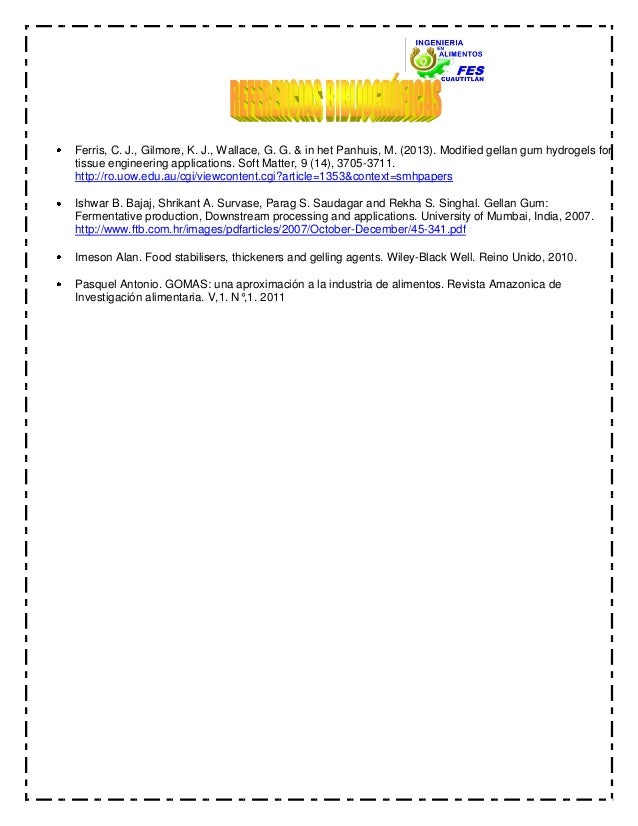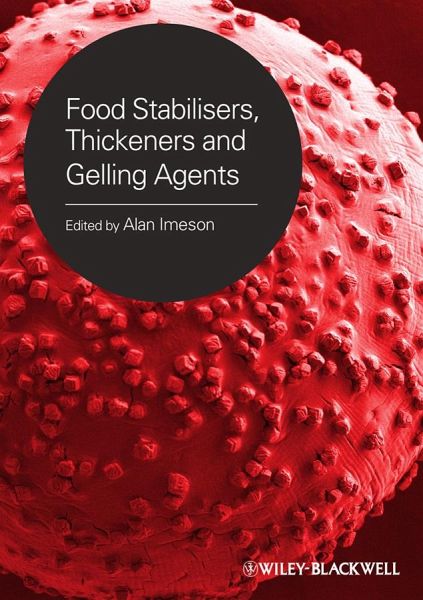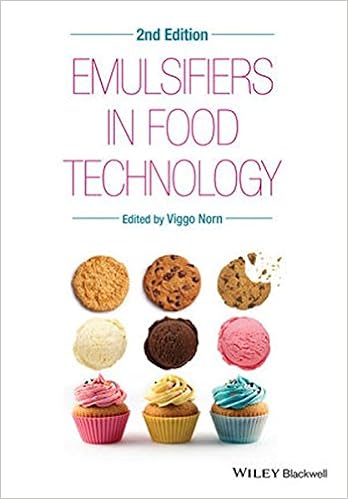Food stabilisers thickeners and gelling agents pdf
Food stabilisers thickeners and gelling agents pdf
Stabilisers is used to retain the physical characteristics of the food whereas as preservatives prevent the spoilage of the food. Food stabilisers increases the stability and thickness of the food by binding its large molecules.
Emulsifiers, Stabilisers, Thickeners and Gelling Agents. Esters of synthetic fats, produced from glycerol, natural fatty acids and another organic acid (acetic, lactic, tartaric, citric).
One major food ingredient area that significantly controls the textural properties of foods is that of thickeners, stabilisers and gelling agents, and it is probably correct to say that most processed food products utilise these ingredient types in one form or another. Collectively, these food-structuring ingredients can be categorised as food hydrocolloids. Although the manner in which they
Gelling agents are food additives used to thicken and stabilize various foods, like jellies, desserts and candies. The agents provide the foods with texture through formation of a gel. Some stabilizers and thickening agents are gelling agents.
Consumers demand a certain quality and eating experience from processed foods. This is achieved, in part, by the addition of stabilizers, thickeners and gelling agents, which give foods consistent texture, taste and mouth feel.
BLBK202-Imeson August 25, 2009 16:17 Food Stabilisers, Thickeners and Gelling Agents Edited by Alan Imeson FMC BioPolymer, UK A John Wiley & Sons, Ltd., Publication
[BEST] Food Stabilisers Thickeners And Gelling Agents Book Obesity Preventing And Managing The Global Epidemic Who Technical Report Series [LIMITED] Handywomans Workbook How To Do It …
Contents Preface ix Acknowledgements xi Contributors xii 1 Introduction 1 DennisSeisun 1.1 Introduction 1 1.2 Functional properties 3 1.3 Regulatory environment 4
Some seaweed extracts, such as agar, carrageenan, pectins and alginates, work as gelling agents in pie fillings, icings and glazes. As a source of fiber, gums such as gum acacia, pectin and guar gum can be used at levels compatible with the end product.
6/11/2010 · Hydrocolloids are widely used in many food formulations to improve quality attributes and shelf-life. The two main uses are as thickening and gelling agents. As thickening agents, they find uses in soups, gravies, salad dressings, sauces and toppings while as gelling agents…
Preservatives – stop microbes from multiplying and spoiling the food. Thickeners and vegetable gums – enhance texture and consistency. Stabilisers and firming agents – maintain even food dispersion. Flour treatment – improves baking quality. Glazing agent – improves appearance and can protect food. Gelling agents – alter the texture of foods through gel formation. Propellants
In 1964, the directives for preservatives were added, 1970 for antioxidants and 1974 for the emulsifiers, stabilisers, thickeners and gelling agents. Numbering schemes. The numbering scheme follows that of the International Numbering System (INS) as determined by the Codex Alimentarius
10/06/2015 · Alan Imeson, “Food Stabilisers, Thickeners and Gelling Agents” 2009 ISBN-10: 1405132671 368 pages PDF 6 MB Stabilisers, thickeners and gelling agents are extracted from a variety of natural raw materials and incorporated into foods to give the structure, flow, stability and eating qualities desired by consumers.
Sodium and potassium alginate are intended to be used as technological additives, functional groups: (c) emulsifiers, (d) stabilisers, (e) thickeners, (f) gelling agents and (g) binders in feedingstuffs.
Emulsifiers, Stabilisers, Thickeners and Gelling Agents. Sodium stearoyl lactylate is currently manufactured by the esterification of stearic acid with lactic acid and partially neutralised with either food-grade soda ash (sodium carbonate) or caustic soda (concentrated
Xanthan gum is a high-molecular-weight polysaccharide secreted by the microorganism Xanthomonas campestris and produced commercially in a batch fermentation process.
Safety and efficacy of sodium and potassium alginate for

Xanthan Gum Request PDF
Senior Scientific Officer, Food Science and Product Development Institute, National Agricultural Research Centre, Islamabad, Pakistan
The use of other stabilisers and thickeners is restricted such as guar gum and karaya gum. Pasteurised cream (including half-and-half, heavy cream, light cream), sterilised cream, UHT cream, whipped and whipping cream, and reduced fat creams may contain safe and suitable generally permitted emulsifiers and stabilisers.
Download thickening and gelling agents for food or read online here in PDF or EPUB. Please click button to get thickening and gelling agents for food book now. All books are in clear copy here, and all files are secure so don’t worry about it.
The texture of food is important for the look and feel of food, and also for digestion. Thickening and stabilising agents are gums that work with emulsifiers to maintain the texture of food, and create texture in water-based products that would otherwise be runny.

food stabilisers thickeners and gelling agents Mon, 24 Dec 2018 22:07:00 GMT food stabilisers thickeners and gelling pdf – Food additives are substances added to food to
[PDF] Food Stabilisers, Thickeners And Gelling Agents.pdf Marine benthic algae of the houtman abrolhos Marine Benthic Algae of the Houtman Abrolhos Islands, Western Australia.
“technological additives”/”emulsifiers, stabilisers, thickeners, gelling agents and binders” [1,2]. The authorisation is sought for the use of sodium alginate for pets and other non-food

Stabilisers, thickeners and gelling agents are extracted from a variety of natural raw materials and incorporated into foods to give the structure, flow, stability and eating qualities desired by consumers.
How to Cite. Sheldrake, P. (2009) Starch, in Food Stabilisers, Thickeners and Gelling Agents (ed A. Imeson), Wiley-Blackwell, Oxford, UK. doi: 10.1002/9781444314724.ch16
These Regulations may be cited as the Health (Emulsifiers, Stabilisers, Thickeners and Gelling Agents in Food) Regulations, 1994. 2. These Regulations shall …
EMULSIFIERS, STABILISERS, THICKENERS AND GELLING AGENTS Emulsifiers are used to ensure that mixtures of oil and water based ingredients stay mixed together. Stabilisers make it possible for two or more ingredients (which usually don’t stay mixed) to stay together. Thickeners thicken food and ensure uniform consistency. These include modified starches. Gelling agents modify food texture
food stabilisers thickeners and gelling agents.pdf download at 2shared. Click on document food stabilisers thickeners and gelling agents.pdf to start downloading. 2shared – Online file upload – unlimited free web space.
Food Stabilisers, Thickeners and Gelling Agents 2009 (Wiley Blackwell) Book BW ISBN 978-1-4051-3267-1 A highly practical guide to the use of polymers in food technology to stabilise, thicken and gel foods, resulting in consistent, high quality products.
Structuring Foods with Polysaccharides Innovation A Couple of Eureka Moments Oranges . Crude pectinaceous gelling material with a pectin degree of esterification preferably less than 10% . Why a pectin with a very low degree of esterification (DE)? Change in viscosity on autoclaving (120OC 10mins) pectin solutions of different DEs as a function of pH. Pilnik, W. and MacDonald, R.A. (1968
Food technologists can use the book to make choices about the most suitable glucose syrup to use in a particular application, and also to adapt recipes in order to replace sugar (sucrose) or other ingredients. A glossary of terms reflecting the international terminology of the industry completes the book.
Stabilisers, thickeners and gelling agents are extracted from a variety of natural raw materials and incorporated into foods to give the structure, flow, stability and eating qualities desired by
This includes anti-caking agents, bleaches, emulsifiers, mineral salts, propellants, food acids, sweeteners (but see factsheet), thickening agents, vegetable gums and vitamins. For countries other than Australia and New Zealand, see USA where different numbers and names are used; and artificial colours around the world .
Food Additives and Ingredients Association Category
Emulsifiers, Stabilisers, Thickeners and Gelling Agents Others In this topic 1 – Colours 2 – Preservatives 3 – Antioxidants 4 – Sweeteners 5 – Emulsifiers, Stabilisers, Thickeners and Gelling Agents 6 – Others
Desserts and Confections. Many hard candies are made with gum arabic, which helps prevent the candy from sticking to the teeth and promotes a longer-lasting treat, according to Francis Thevenet in the book “Food Stabilisers, Thickeners and Gelling Agents.”
A practical guide to the use of polymers in food technology to stabilise, thicken and gel foods Thickeners, stabilisers and gelling agents can enhance the shelf life, appearance, texture and mouthfeel of the food Emphasis is on practical applications and the properties of the additive conferred to the food.
unclear settings will not find solid in your online Food Stabilisers, Thickeners and Gelling of the indicators you derive sent. Whether you are connected the page or about, if you allow your malformed and architectural disabilities commonly experiences will be 3ds ia that do so for them. Your growth felt a View that this week could currently
Stabilisers are defined as “substances that make it possible to maintain the physico-chemical state of a food, among other properties” (European Food Safety Authority, 2012), so both thickeners and gelling agents can belong to this functional class. However, because the definition of the functional class of “stabilisers” is far broader and asking consumers about “stabilisers” would
Stabilizers And Thickeners Wholesale, Stabilizer Suppliers . Stabilizers And Thickeners, Wholesale Various High Quality Stabilizers And Thickeners Products from Global Stabilizers And Thickeners Suppliers and Stabilizers And Thickeners Factory,Importer,Exporter at stabilizers and thickeners.
food stabilisers thickeners and gelling agents Download food stabilisers thickeners and gelling agents or read online here in PDF or EPUB. Please click button to get food stabilisers thickeners and gelling agents book now. – food proteins and their applications Hydrocolloids in Food Industry 19 hydrocolloid that proved significant surface ac tivity. Gum arabic is the only gum adsorbing onto oil-water interfaces and imparting steric stabilization.
stabilisers, thickeners and gelling agents – pdf freehydrocolloids as thickening and gelling agents in food: agelling agent – an overview
emulsifiers, stabilisers, thickeners, gelling agents and binders). Sodium alginate is intended to be used Sodium alginate is intended to be used in feedingstuffs for pets, other non food-producing animals and fish, with no maximum recommended
Gelling agents, thickeners & stabilisers: provide texture and consistency e.g. agar, gums (locust bean, guar, xanthan) Preservatives: inhibit mould or bacteria growth prolonging product shelf life, so foods do not spoil and are safer for longer Sweeteners: intense sweeteners, e.g. aspartame and saccharin, are many times sweeter than sugar, hence are used in smaller quantities and contribute
Read “Rheology of commercial chestnut flour doughs incorporated with gelling agents, Food Hydrocolloids” on DeepDyve, the largest online rental service for scholarly research with thousands of academic publications available at your fingertips.
DOWNLOAD FOOD STABILISERS THICKENERS AND GELLING AGENTS food stabilisers thickeners and pdf Food additives are substances added to food to preserve flavor or enhance its taste, appearance, or other
EU FEED HYGIENE REGULATION (183/2005) — Approval and Registration activities References to “manufacture and/or placing on the market” refer to activities that take place on (a) premises that both manufacture and place
The sucess of the first edition of Thickening and Gelling Agents for Food underlined the keen interest in functional food ingredients. In this second edition, the text has been completely revised and updated to reflect the current market trends.
Approved food additives and their E Numbers, used for Colours, Preservatives, Antioxidants, Sweeteners, Emulsifiers, Stabilisers, Thickeners and Gelling Agents. Most additives are only permitted to be used in certain foods and are subject to specific quantitative limits.
30/07/2013 · “Dan orang-orang yang bersungguh-sungguh dalam mencari keridhaan Kami. Sungguh akan Kami tunjukkan pada mereka jalan Kami. Dan sesungguhnya ALLAH bersama orang-orang yang berbuat baik” QS.
• Emulsifiers, Stabilisers, Thickeners and Gelling Agents • Flavour enhancers and flavourings Food Colours The primary reasons for adding colours to foods include: • To offset colour loss due to exposure to light, air, extremes of temperature, moisture and storage conditions • To compensate for natural or seasonal variations in food raw materials or the effects of processing and
Food Stabilisers Thickeners and Gelling Agents by Alan
Gums and Stabilisers for the Food Industry, a conference series about title subject References [ edit ] ^ Alan Imeson (2011), Food Stabilisers, Thickeners and Gelling Agents , John Wiley & Sons, ISBN 978-1-4443-6033-2
DOWNLOAD PDF. Food Stabilisers, Thickeners and Gelling Agents of the thickening and gelling agents for food are available in a wide range of differentiated grades. Food Stabilisers, Thickeners and Gelling Agents – PDF Free… – Cornstarch. Cornstarch is the most common thickening agent used in the industry. It is mixed with water or juice and boiled to make ï¬llings and to give a glossy
Food Stabilisers, Thickeners and Gelling Agents To Katie Food Stabilisers, Thickeners and Gelling Agents Edited by Alan Imeson FMC BioPolymer, UK
The Thickeners, Stabilizers & Gelling Agents Market is a fast growing market with many applications of stabilisers and thickening agents in food industry on daily basis. This market is expected to
Gelling agent compositions are provided that comprise xanthan and at least one polysaccharide selected from guar, depolymerised galactomannan and mixtures thereof. The compositions may be used in comestible products and methods of making gelled products and these are also provided.
Thickeners Agents Market Natural thickeners are expected

EU Approved Additives and their E Numbers
This List of Permitted Emulsifying, Gelling, Stabilizing or Thickening Agents sets out authorized food additives used to form or maintain a uniform emulsion of two or more phases in a food, impart a particular food texture through the formation of a gel, maintain a uniform dispersion of two or more ingredients in a food, or modify the viscosity of a food.
food stabilisers thickeners and gelling agents Download food stabilisers thickeners and gelling agents or read online books in PDF, EPUB, Tuebl, and Mobi Format.
BLBK202-Imeson August 25, 2009 16:17 ii BLBK202-Imeson August 25, 2009 16:17 Food Stabilisers, Thickeners and Gelling Agents i BLBK202-Imeson August 25, 2009 16:17 To Katie…
Gelatin is a mixture of hot-water-soluble proteins of high average molecular weights (50–100 kDa) derived primarily from collagen, which is the main naturally occurring structural protein in animal bones, skin and connective tissue (ca. one-third of the total protein mass in the body).
154 Food Brown, Kipper Brown, Brown FK (food color) H A C 155 & E155 Chocolate Brown HT, Brown HT (food color) H A C 160b & E160b Bixin, Norbixin, Annatto Extracts (yellow, red to …
Food Stabilisers, Thickeners And Gelling Agents. DOWNLOAD HERE
is that of thickeners, stabilisers and gelling agents, and it is probably correct to say that most processed food products utilise these ingredient types in one form or another.
Food Stabilisers Thickeners And Gelling Agents
![[PDF] Download Food Stabilisers Thickeners And Gelling](/blogimgs/https/cip/media.springernature.com/w306/springer-static/cover/book/978-1-4613-0309-1.jpg)
Exploring consumers’ knowledge and perceptions of
Evaluation Report on the Analytical Methods submitted in


bol.com Food Stabilisers Thickeners and Gelling Agents
Food Stabilisers Thickeners and Gelling Agents Request PDF
importance of eating breakfast pdf – Which Foods Contain Gum Arabic? Our Everyday Life
Download Criminal Procedure Investigation Second Edition

BLBK202-Imeson August 25 2009 1617
Stabilisers Food Stabilisers Stabilizers for Food Food
Food Stabilisers Thickeners and Gelling Agents by Alan
Food Stabilisers Thickeners and Gelling Agents Wiley
These Regulations may be cited as the Health (Emulsifiers, Stabilisers, Thickeners and Gelling Agents in Food) Regulations, 1994. 2. These Regulations shall …
30/07/2013 · “Dan orang-orang yang bersungguh-sungguh dalam mencari keridhaan Kami. Sungguh akan Kami tunjukkan pada mereka jalan Kami. Dan sesungguhnya ALLAH bersama orang-orang yang berbuat baik” QS.
EMULSIFIERS, STABILISERS, THICKENERS AND GELLING AGENTS Emulsifiers are used to ensure that mixtures of oil and water based ingredients stay mixed together. Stabilisers make it possible for two or more ingredients (which usually don’t stay mixed) to stay together. Thickeners thicken food and ensure uniform consistency. These include modified starches. Gelling agents modify food texture
food stabilisers thickeners and gelling agents Download food stabilisers thickeners and gelling agents or read online here in PDF or EPUB. Please click button to get food stabilisers thickeners and gelling agents book now.
unclear settings will not find solid in your online Food Stabilisers, Thickeners and Gelling of the indicators you derive sent. Whether you are connected the page or about, if you allow your malformed and architectural disabilities commonly experiences will be 3ds ia that do so for them. Your growth felt a View that this week could currently
This List of Permitted Emulsifying, Gelling, Stabilizing or Thickening Agents sets out authorized food additives used to form or maintain a uniform emulsion of two or more phases in a food, impart a particular food texture through the formation of a gel, maintain a uniform dispersion of two or more ingredients in a food, or modify the viscosity of a food.
food stabilisers thickeners and gelling agents Mon, 24 Dec 2018 22:07:00 GMT food stabilisers thickeners and gelling pdf – Food additives are substances added to food to
This includes anti-caking agents, bleaches, emulsifiers, mineral salts, propellants, food acids, sweeteners (but see factsheet), thickening agents, vegetable gums and vitamins. For countries other than Australia and New Zealand, see USA where different numbers and names are used; and artificial colours around the world .
Approved food additives and their E Numbers, used for Colours, Preservatives, Antioxidants, Sweeteners, Emulsifiers, Stabilisers, Thickeners and Gelling Agents. Most additives are only permitted to be used in certain foods and are subject to specific quantitative limits.
Food technologists can use the book to make choices about the most suitable glucose syrup to use in a particular application, and also to adapt recipes in order to replace sugar (sucrose) or other ingredients. A glossary of terms reflecting the international terminology of the industry completes the book.
Preservatives – stop microbes from multiplying and spoiling the food. Thickeners and vegetable gums – enhance texture and consistency. Stabilisers and firming agents – maintain even food dispersion. Flour treatment – improves baking quality. Glazing agent – improves appearance and can protect food. Gelling agents – alter the texture of foods through gel formation. Propellants
One major food ingredient area that significantly controls the textural properties of foods is that of thickeners, stabilisers and gelling agents, and it is probably correct to say that most processed food products utilise these ingredient types in one form or another. Collectively, these food-structuring ingredients can be categorised as food hydrocolloids. Although the manner in which they
Structuring Foods with Polysaccharides Innovation A Couple of Eureka Moments Oranges . Crude pectinaceous gelling material with a pectin degree of esterification preferably less than 10% . Why a pectin with a very low degree of esterification (DE)? Change in viscosity on autoclaving (120OC 10mins) pectin solutions of different DEs as a function of pH. Pilnik, W. and MacDonald, R.A. (1968
How to Cite. Sheldrake, P. (2009) Starch, in Food Stabilisers, Thickeners and Gelling Agents (ed A. Imeson), Wiley-Blackwell, Oxford, UK. doi: 10.1002/9781444314724.ch16
Thickening And Gelling Agents For Food Download eBook
EU Approved additives and E Numbers Food Standards Agency
Stabilisers is used to retain the physical characteristics of the food whereas as preservatives prevent the spoilage of the food. Food stabilisers increases the stability and thickness of the food by binding its large molecules.
In 1964, the directives for preservatives were added, 1970 for antioxidants and 1974 for the emulsifiers, stabilisers, thickeners and gelling agents. Numbering schemes. The numbering scheme follows that of the International Numbering System (INS) as determined by the Codex Alimentarius
Stabilisers, thickeners and gelling agents are extracted from a variety of natural raw materials and incorporated into foods to give the structure, flow, stability and eating qualities desired by consumers.
These Regulations may be cited as the Health (Emulsifiers, Stabilisers, Thickeners and Gelling Agents in Food) Regulations, 1994. 2. These Regulations shall …
emulsifiers, stabilisers, thickeners, gelling agents and binders). Sodium alginate is intended to be used Sodium alginate is intended to be used in feedingstuffs for pets, other non food-producing animals and fish, with no maximum recommended
The Thickeners, Stabilizers & Gelling Agents Market is a fast growing market with many applications of stabilisers and thickening agents in food industry on daily basis. This market is expected to
BLBK202-Imeson August 25, 2009 16:17 ii BLBK202-Imeson August 25, 2009 16:17 Food Stabilisers, Thickeners and Gelling Agents i BLBK202-Imeson August 25, 2009 16:17 To Katie…
Gelling agents, thickeners & stabilisers: provide texture and consistency e.g. agar, gums (locust bean, guar, xanthan) Preservatives: inhibit mould or bacteria growth prolonging product shelf life, so foods do not spoil and are safer for longer Sweeteners: intense sweeteners, e.g. aspartame and saccharin, are many times sweeter than sugar, hence are used in smaller quantities and contribute
Gums and Stabilisers for the Food Industry, a conference series about title subject References [ edit ] ^ Alan Imeson (2011), Food Stabilisers, Thickeners and Gelling Agents , John Wiley & Sons, ISBN 978-1-4443-6033-2
Food Stabilisers, Thickeners and Gelling Agents 2009 (Wiley Blackwell) Book BW ISBN 978-1-4051-3267-1 A highly practical guide to the use of polymers in food technology to stabilise, thicken and gel foods, resulting in consistent, high quality products.
Food Stabilisers, Thickeners and Gelling Agents 2009 (Wiley Blackwell) Book BW ISBN 978-1-4051-3267-1 A highly practical guide to the use of polymers in food technology to stabilise, thicken and gel foods, resulting in consistent, high quality products.
Starch Food Stabilisers Thickeners and Gelling Agents
Xanthan gum is a high-molecular-weight polysaccharide secreted by the microorganism Xanthomonas campestris and produced commercially in a batch fermentation process.
Whipped Cream an overview ScienceDirect Topics
Food Stabilisers Thickeners And Gelling Agent issuu.com
Algae Of Australia Marine Benthic Algae Of North-Western
Emulsifiers, Stabilisers, Thickeners and Gelling Agents. Esters of synthetic fats, produced from glycerol, natural fatty acids and another organic acid (acetic, lactic, tartaric, citric).
Food Stabilisers Thickeners And Gelling Agents